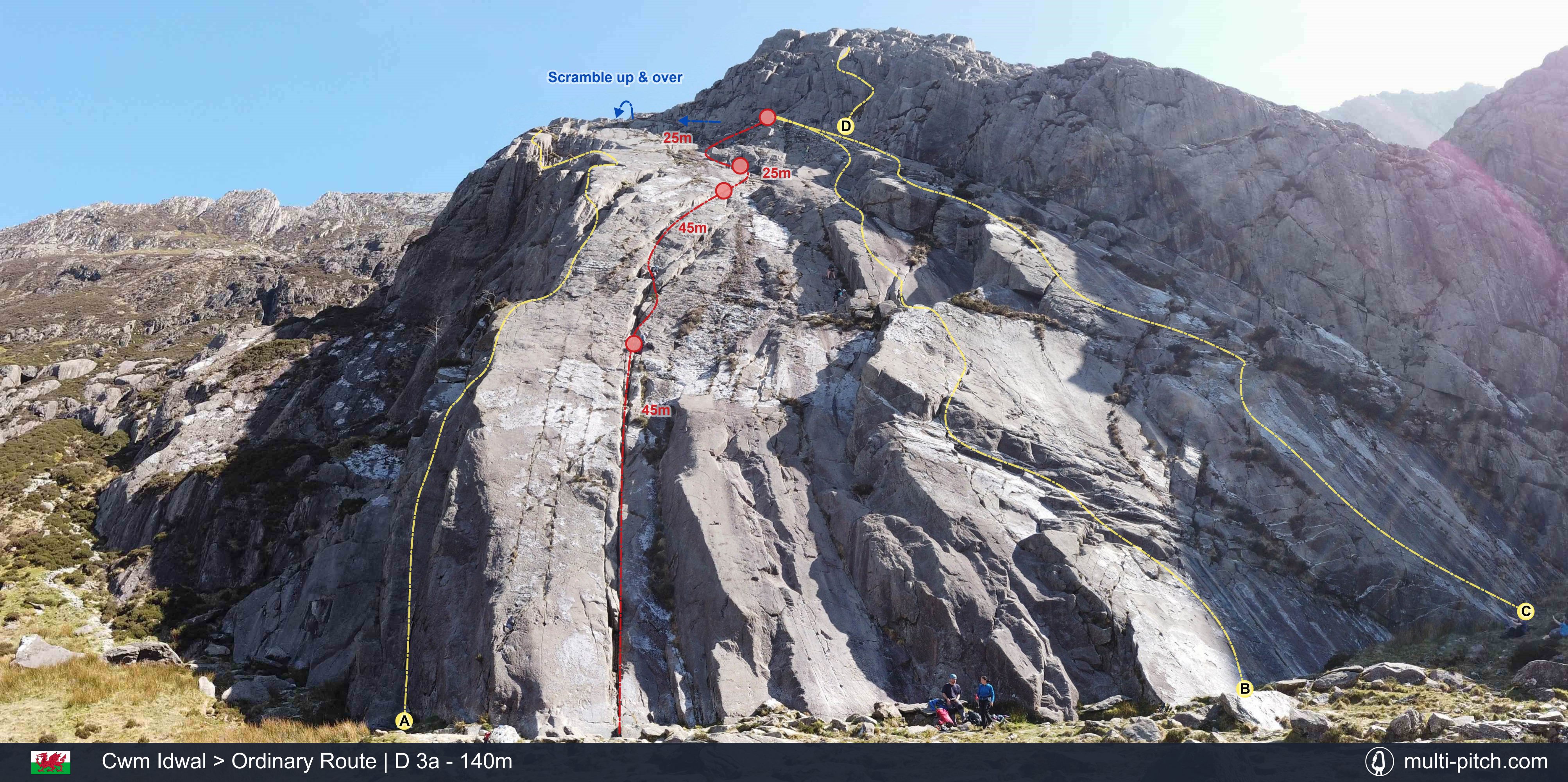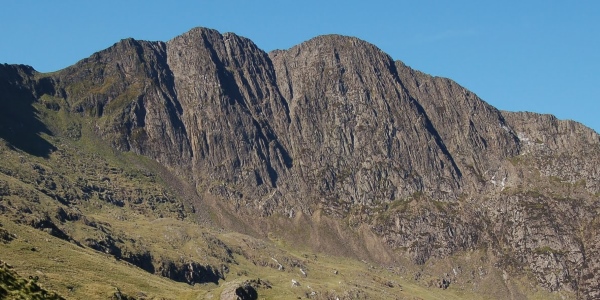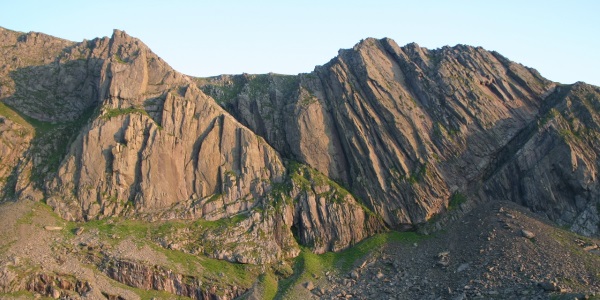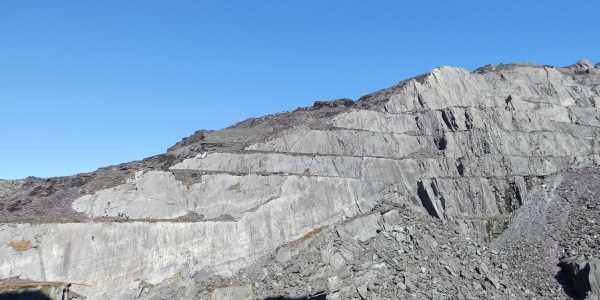Cwm Idwal - Ordinary Route
The Ordinary Route is the easiest route on Idwal Slabs or Rhiwiau Caws as is the propper Welsh name. This climb represents an ideal introduction to trad multi-pitch climbing, as such it's common to see groups of 3 people climbing, led by a guide. The descent can prove tricky, especially in or after wet conditions.The down climbing part of the descent is on a shaded corner of the mountain so typically won't dry as quickly as the slabs. Expect some polish on the route as well. The views are stunning and get better as the route progresses. The route is typically climbed over 4 pitches with more scrambling after the 4th pitch. Route finding higher on the slabs can be a little tricky. It's fair to say stamina is more important than any great technical climbing skill to get up the Ordinary Route.
The Route Topography
This is the route Ordinary Route on Cwm Idwal in Gwynedd, Wales. It represents 140m of Rhyolite rock climbing, usually over 4 pitches, of a max grade of D 3a. Clicking the image will load the full screen high resolution Ordinary Route climb topo.
Original Image: Our own image
Alternative Routes
A. Tennis Shoe | HS 4b - 141m
It’s hard to imagine this being first climbed solo in 1919 by Noel Ewart Odell. The route is incredible and takes a stunning line above the steep East Wall. The route is usually done in 6 pitches with the crux (4b) on the last pitch. The crux can be avoided by climbing the easier broken rock to the right. The route ends on the left side of the top of the Idwal Slabs. The first pitch can be upgraded to HVS 5a by taking a gearless direct line up to the second belay point.
B. Minerva / Hope | VDiff 3b - 160m
Hope is one of the most popular routes in wales and can therefore be polished in places. The route is exceptional and mostly quite straightforward. 5 pitches are the norm and running together the middle pitches can cause ropework issues around the cracked corner section. The route is climbable in rain, although it will mean having to make anchor points in a small waterfall, which is not recommend and likely very unsafe. The line was originally thought impenetrable by the top climbers of the time like O.G. Jones. This route was first climbed by Emily Hilda Daniell in 1915 and named Minerva after the Roman godess. The route is more commonly known as Hope today. Given Faith and Charity were climbed the year after Minerva and Emily Daniells was not a first ascensionist of these 2 subsequent routes, it's unclear how appropriate this re-naming of the route is. The route sits between the routes Charity and Faith. Faith, Hope & Charity are Christian Theological virtues.
C. Faith | VDiff 3b - 151m
The route Faith takes a line up the right-hand side of the Idwal Slabs. It’s a quality route, although more likely to suffer seepage than the other lines. It’s usually done in 5 pitches and requires some confidence with footwork early on but offers little in the way of technical challenge. It is also an ideal line to take if heading up the Holly Tree Wall or Continuation Wall because it ends directly by them.
D. Lazarus | S 4a - 40m
Although a higher grade and therefore harder finish than many of the routes up the Idwal Slabs, Lazarus offers and exceptional end to any of the routes listed. It’s also the easiest route up the Holly Tree Wall at grade Severe. The holds are good and protection plentiful. The wall will look and feel steep and exposed after climbing the slabs below. The first pitch of Lazarus moves up into the gully and is fine but not super interesting. The second pitch is incredible. It traverses out on the steep Holly Tree Headwall before climbing up past a clean-cut looking block, passing on the right. Then following an easier gully up onto a large ledge of the continuation wall. From the ledge, another pitch can be taken up The Groove Above (also Severe). There are also a number of alternative pitch options ranging from grade Diff like The Upper Staircase to HVS like Continuation Crack. Climbers could also scramble off.
Approach & Descent Information
Approach: Take the main path from Ogwen Cottage to Llyn Idwal and continue around the left-hand side of the lake towards the slabs which are straight ahead of you. Any attempt at a shortcut off the path will likely slow you down.
Descent: Getting off the mountain can prove tricky. From the last pitch, scramble across the crag moving up and left, consider staying roped if with beginners. As the party moves back there is the option to down-climb or abseil off the back corner of the cliff. This section is steeper than the climbing on the route albeit with better holds and much shorter. Less confident parties may wish to abseil or get a belay from above while down climbing. Once the steep part has been navigated the scree path will take climbers back to the base of the Idwal Slabs.
See Cwm Idwal on the climb map Open climb location in Google Maps
Pitch By Pitch Information
First climbed in 1897 the Ordinary Route is the easiest climb up the Idwal slabs. That said the route Hope is not much more challenging (and a better climb). The Ordinary Route offers a good introduction to multi-pitch climbing, and as such it's often a busy climb and used by guides quite a lot. Unless it’s raining the slabs at Cwm Idwal can be busy. Climbers can ascend this route in bad weather if they are brave.
Pitch 1 –45m
Follow the obvious crack to a wedged block and either belay there or on a better ledge above.
Pitch 2 –45m
After the belay, take the left hand grove working up and left slightly before following a long rightwards leaning line of weakness up to some ledges where another belay can be made.
Pitch 3 –25m
Follow the crack up towards a ledge, the route becomes much less clear here with multiple options for creating an anchor. Ideally take the easiest climbing.
Pitch 4 –25m
The final official pitch goes left for about 8m then up and right towards a much larger ledge system. A shorter, slightly harder and more direct line can be taken. After this there is a reasonable amount of scrambling left and then up to get to the downclimb or abseil. Instead of the scramble, climbers can continue up on the harder continuation wall. This will add more length to this route at a higher grade. Lazarus to the far right is the easiest and arguably best way up if you want to continue with harder climbing.
Guidebooks
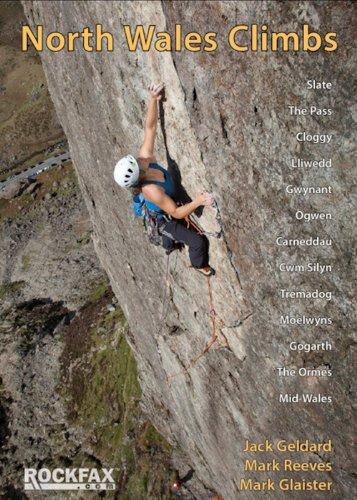
North Wales Climbs - pg. 191
North wales has plenty of Trad climbs above 50m. This book covers a good selection of climbs from a good selection of cliffs, including a variety of routes up the Idwal Slabs. The book is very much a worthwhile investment for any rock climbing trip to the Llanberris and Snowdon area of Wales.
Availible Here
R.R.P. £ 24.99
ISBN: 9781873341827
Weather & Local Conditions
Seasonal Weather Information
Note that some weather stations are close or even on the mountain, others are in nearby towns. Plan accordingly!
Estimated Rainy Days Per Month
- 13
- 10
- 11
- 9
- 8
- 8
- 8
- 9
- 10
- 14
- 14
- 14
The graph shows the estimated average number of rainy days in the month that had more than 1mm rainfall or snow:
Estimated Temperature Per Month
- 83
- 82
- 93
- 124
- 157
- 1710
- 1912
- 1812
- 1710
- 138
- 105
- 83
Estimated average high and low temperature in degrees Celsius for the given month.
References & additional links
The following links will take you to external websites specifically related to this climb: Ordinary Route on Cwm Idwal.
Note: They contained relevant information at the time of publishing.
Listed Nearby Climbs
The are some top quality multi-pitch rock climbs nearby. Guidebooks (see above) will have a more comprehensive list of other local climbing venues.
Longlands Continuation on Lliwedd
280m climb graded S 4b.
5.9km away
Great Slab on Clogwyn Dur Arddu
162m climb graded VS 4c.
5.7km away
Australia West Face on Dinorwic Quarry
113m climb graded E1 5b.
5.2km away
Cneifion Arete on Cwm Cneifion
120m climb graded Diff.
0.4km away
There are currently over 40 published multi-pitch climbs on the site.
View All Listed Rock Climbs

